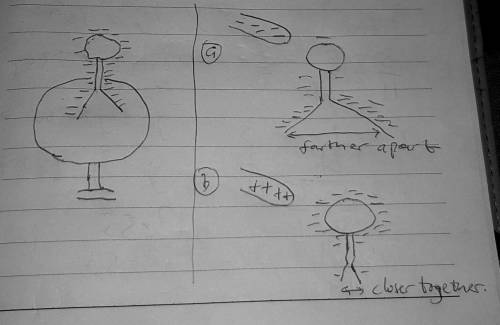
Physics, 05.05.2020 19:45 arlabbe0606
1. A negatively charged electroscope has separated leaves. a. Suppose you bring a negatively charged rod close to the top of the electroscope, but not touching. How will the leaves respond? Use both charge diagrams and words to explain. b. How will the leaves respond if you bring a positively charged rod close to the top of the electroscope, but not touching? Use both charge diagrams and words to explain.

Answers: 2
Another question on Physics

Physics, 21.06.2019 16:10
Alow cost, low earth orbit (leo) satellite is to be fabricated at a university, for subsequent launch by rocket. what are the constraints and objectives for selection of a material suitable for the satellite bus (i.e. the structure)? explain each in brief. (15 marks) b)suggest sources of data which could support the selection of materials for applications in space. (5 marks) c) set weights for the objectives listed in (2a) using the digital logic method. (5 marks)
Answers: 1

Physics, 21.06.2019 17:10
The dissociation energy of a molecule is the energy required tobreak apart the molecule into its separate atoms. the dissociationenergy for a particular molecule is 5.48 x 10-18 j.suppose that this energy is provided by a single photon. determinethe (a) wavelength and (b) frequency of the photon
Answers: 1

Physics, 21.06.2019 21:20
Which of the following explains why it took so long for the public to accept the negative health effects of smoking? a)people were waiting for counter reasons, and those were presented.b)scientists had not completely finalized their results, which took 30 years.c)cigarettes were cheaply available and media channels were very inefficient.d)cigarette manufacturers were trying hard to bring an alternative into the market
Answers: 3

Physics, 21.06.2019 22:30
Fft review: linspace, fs, fftshift, nfft 1. generate one second of a cosine of w,-10hz sampled at f, = 100hz and assign it to x. define a tt as your time axis 2. take 64 points fft. 3. as you remember, the dft (which the fft implements) computes n samples of s2t where k-0,1,2, n -1. plot the magnitude of this 64-points fft at range 0 to 63, what do you think of this graph? 4â·to get the x-axis into a hz-frequency form, plot this 64-points fft between-50 to 50 (the 100hz sampling rate) and have n-points between them. 5. according to your figure, what frequency is this cosine wave at? 6. remember that the fft is evaluating from 0 to 2ď€. we are used to viewing graphs from-ď€ to ď€. therefore, you need to shift your graph. 7. now according to your shifted graph. what frequency is this at? 8. note that the spikes have long drop-offs? try a 1024-point dft. note that the peak is closer to 10 and the drop-off is quicker. although, now sidelobes are an issue
Answers: 2
You know the right answer?
1. A negatively charged electroscope has separated leaves. a. Suppose you bring a negatively charged...
Questions

Mathematics, 04.12.2020 05:00


English, 04.12.2020 05:00


Mathematics, 04.12.2020 05:00

Mathematics, 04.12.2020 05:00

Mathematics, 04.12.2020 05:00




Mathematics, 04.12.2020 05:00






English, 04.12.2020 05:00

Social Studies, 04.12.2020 05:00

English, 04.12.2020 05:00




